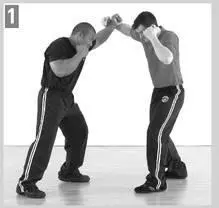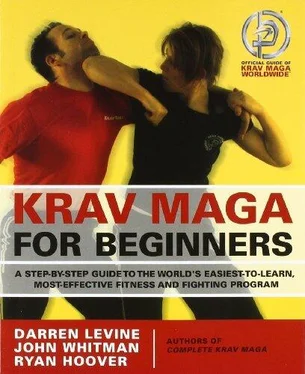
3An attacker stands slightly to your left and throws a straight punch. Roll your left forearm upward, rotating your forearm and wrist as you do, to redirect the punch upward. At the same time, make a body defense by contracting your abs and bending your knees slightly to drop below the punch.
4An attacker stands slightly to your left and throws a straight punch. Stab your left hand outward, keeping your elbow down, so that your hand and arm slide along his arm, redirecting it. Keep your head tucked low but your eyes forward so that you can see the fight. Also, keep your shoulders square to the attacker. As you feel his arm being redirected, open your defending arm outward to further move the punch away from you. This is a “stabbing” defense, and is the prelude to Stick Defenses that you’ll learn later on in Krav Maga.
5An attacker stands very much to the side (note the difference from the other positions). Make a motion similar to #1 and #2, but lead with the pinky side of your hand and open your shoulder more to the side to redirect the punch away from you. Make a small body defense.
Note: Although most of these defenses work in all situations, some are preferred against certain specific attacks. For instance:
Defense #5 (leading with the pinky) is much better against attacks from the side than attacks from the front because when the pinky leads the motion, the shoulder tends to be weak until it opens up more.
Defense #4 (stabbing defense) is an excellent defense if you see the attack early and want to burst forward, defending it before it can get close to you. Also, the stabbing defense is very good against big “haymaker” punches because it allows you to burst in aggressively.
Defense #3 (rolling the arm up) is an excellent all-purpose defense, and works very well against almost all angles of attack.
Defenses #1 are #2 are very similar. Defense #1 (leading with the thumb) tends to redirect the attack more since the rotation of your wrist “rolls” the attack away from you.

Defense against Straight Punch from an Outside Angle
INITIAL COUNTERATTACK→ Straight Punch (page 71). As one hand defends, deliver a straight punch with the other hand. Any straight punch will do, but here are a few specifics for each variation of defense:
• #1 and #2 Straight punch to the face.
• #3 As your arm goes up and your body drops down slightly, send a straight punch either to the face or to the body. The face is preferred, but you may need to punch to the body if you drop low.
• #4 With the stabbing defense, you have an excellent opportunity to make a simultaneous counterattack to the face.
• #5 As the defending arm and shoulder open up, turn your body and throw a straight punch to the face.
NEUTRALIZING THE ATTACKER→ After the initial counterstrike, the defender should continue to attack with punches, kicks, elbows, and knees. Students must focus on rendering the attacker unwilling or unable to continue the assault.
KEY POINTS
• all the defenses are redirecting defenses
• add a body defense
• defend with the hand closest to the attack
COMMONLY ASKED QUESTIONS
Why do we have five different options? Doesn’t Krav Maga try to simplify things and avoid lots of decision making?
Yes, and once you’ve learned all five variations, you should feel free to pick and choose which ones work best for your body. However, each variation has strengths against certain angles, as noted above, so it helps to know them all.
Would I ever use the Outside Defenses if the attacker is standing directly in front of me?
Possibly. Suppose the attacker is standing directly in front of you, but your hands are held too low. When the attacker throws a straight punch, it would take too long to bring your hand up and then make an Inside Defense. An Outside Defense is a faster option.
Would I ever use Defense #5 against an attacker who is more to the front? Do I only use it when the attacker is very much to the side?
Most people find this defense strongest against attacks from the side. However, if you feel you can make a strong defense when the attacker is more forward, you can do so.
Does it ever matter if the attacker throws a left or a right punch?
As long as you can defend near his wrist, it does not matter to the defense at all. If you defend farther up his arm, in some cases the attacker can bend his elbow and come around your defense. Of course, which punch he throws will determine whether you end up on his live or dead side. You should always counterattack aggressively to prevent him from making additional attacks.
Defense against Hook Punch
There are two types of defenses against a Hook Punch: an “extended” defense, which we prefer, and a “covering” defense, which we use when the attacker is very close to us. The extended defenseis very much like a 360° defense. However, there’s a significant change in assumption. In this case, we assume that the defender knows he is in a fight and is not using a reflexive motion. We prefer the extended defense for street fighting because it defends the attack farther from the body; this is beneficial when weapons may be involved. However, there are times when a covering defenseis necessary, especially in a fist fight when the attacker is very close and throwing fast punches.
Defense against Hook Punch (Extended)
ATTACK→ The attacker throws a right hook punch to the head or body.
IMMEDIATE DANGER→ Being struck. The primary danger is being hit.
SECONDARY DANGERS→ Disorientation, balance. If the initial attack is not blocked, the defender may find himself disoriented by the first strike, or have the wind knocked out of him, or be knocked off balance, and therefore open to additional strikes.
SOLUTION→ Hook Punch Defense
1As the attack comes around, block it with your forearm, keeping a 90° bend in your elbow. Make a fist and have the back of your hand face the attack. Usually, you’ll send your arm out to the side in line with your shoulder, but the hook punch can come at a variety of angles, and the most important principle to keep in mind is to defend at the attacker’s wrist. If you defend farther up the arm, the attack may hook around your defense. Tuck your chin and raise your shoulder to help protect your head. You can also add a small body defense by leaning your head slightly forward, inside the arc of the hook punch.

INITIAL COUNTERATTACK→ Straight Punch (page 71). It’s possible to deliver a simultaneous counterattack, although often you’ll find the counterattack coming slightly after the defense. Straight punches are the most likely, but you may also try an elbow (since the attacker tends to be closer when throwing most hook punches).
NEUTRALIZING THE ATTACKER→ After the initial counterstrike, the defender should continue to strike to the body and face. Students must focus on rendering the attacker unwilling or unable to continue the assault.
Читать дальше















